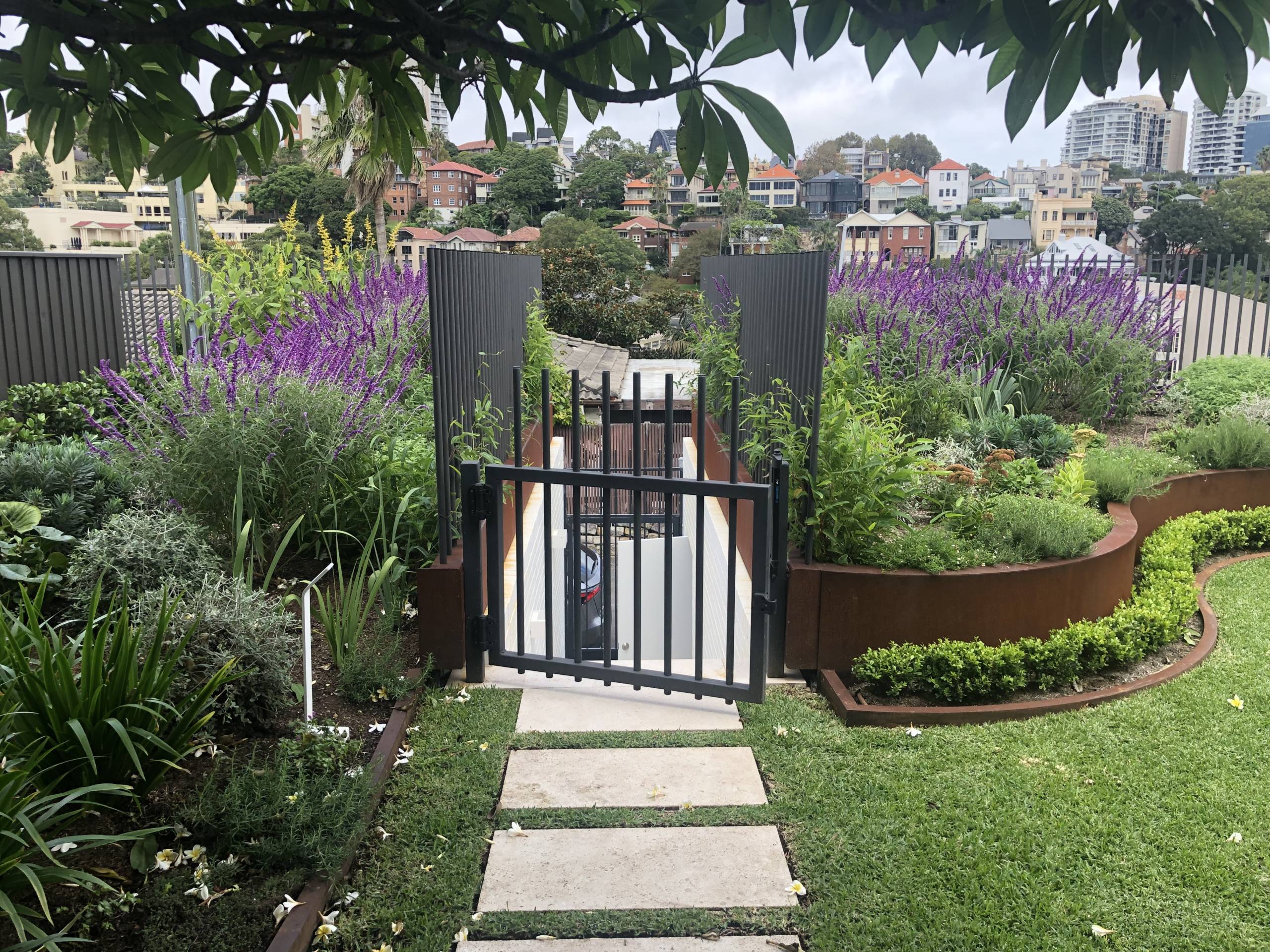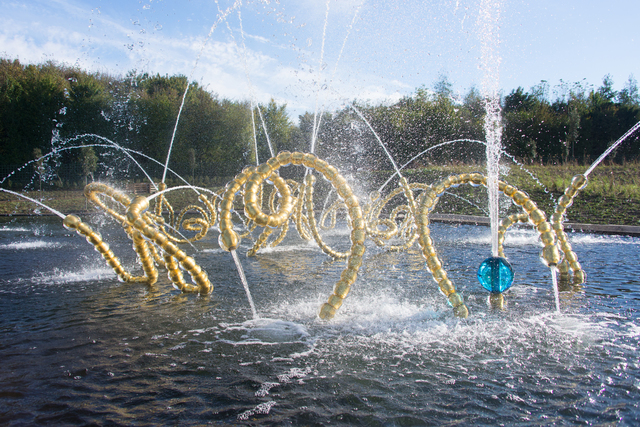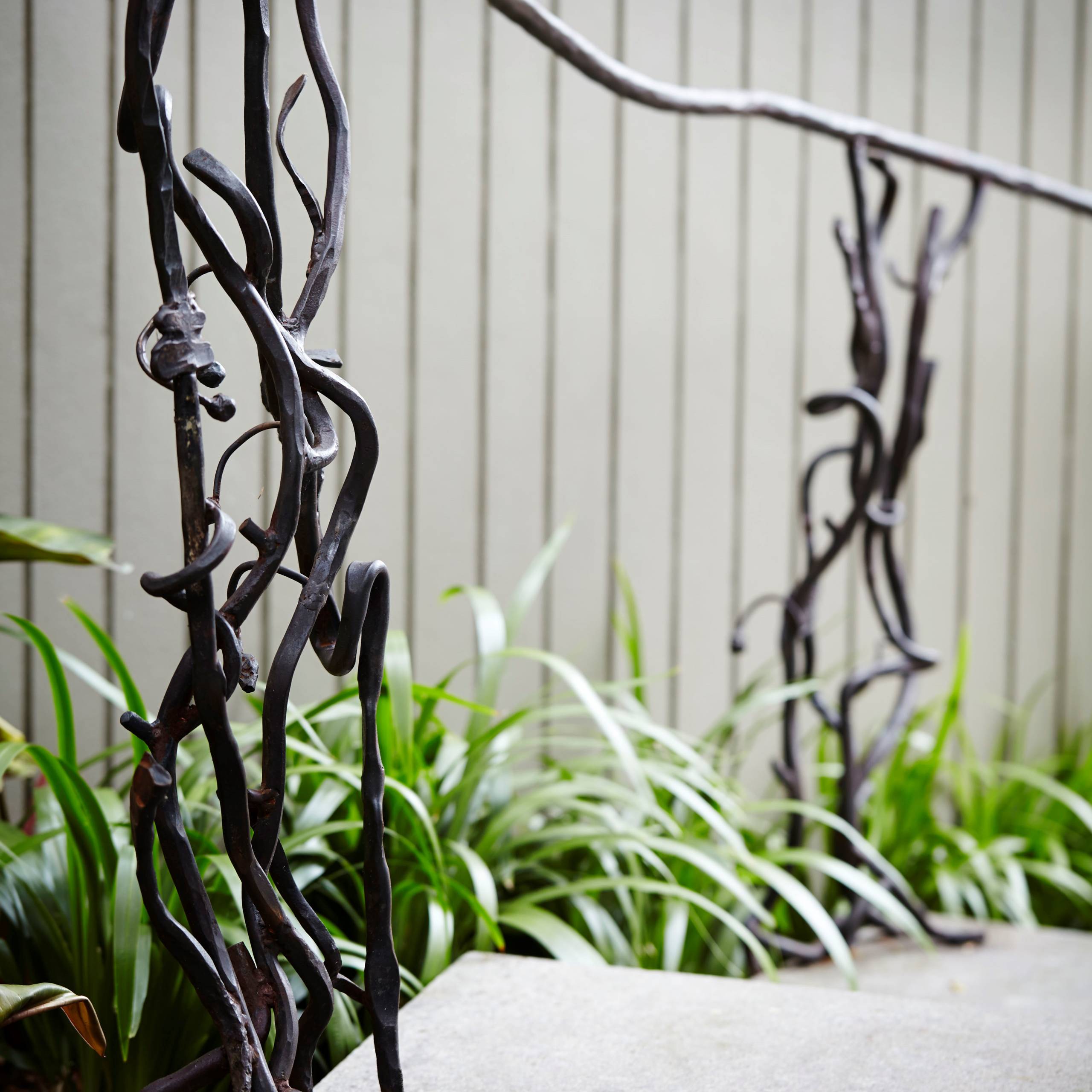Adding a sculpture to the garden is seen by many as a luxury. It’s a nice-to-have addition that one might consider after the landscape design is complete and the budget has been reconciled.
Pepo Botanic Design looks at it the other way around. “The garden is already a work of art,” says landscape architect, Nicola Cameron. “A sculpture becomes part of that work of art and adds a unique individuality. It brings depth and takes the design to a completely new level.”
Selecting functional sculptures
Those in agreeance readily add that their personalised piece of outdoor art is life-enhancing.

The owners of this Parsley Bay home say they “never want to leave” because of their beautiful life-like sculpture, that twists and twines around their home.
The piece threads throughout the space to form an elegant fence line, a front gate and an overhead canopy.
It was intelligently crafted by artist Franceso Petrolo. He designed the ribbon of iron to gently link the contrasting spaces and integrate different elements. The result is both functional and refined. It is now widely recognised as a true example of beautiful landscape architecture. Click here to see more.
Pepo took functionality to a whole new level when designing this rear garden space in North Sydney, picture below.

The homeowners were keen to incorporate a sculptural element and the team integrated a raised curved planter made from corten steel to create the S-shape. The elevated bed also provided the opportunity to import fresh soil and maximise planting.
The wavy design was offset by a vertical rod gate and fenceline – similar to the style you might see in the Mediterranean surrounding vegetable patches. By harmonising shapes, materials and styles Pepo created a statement garden, that is both safe for the client’s grandchildren and welcoming in style.
Creating a focal point
Sculpture creates a focal point and draws the eye to a particular area.
In the case of this Paddington garden, designed by Pepo and pictured below, a twisting copper rod was strategically placed in an awkward corner – shooting up from the soil. The piece was created by internationally renowned sculptor Mark McClelland who began by creating a miniature prototype of the design. He then thoughtfully crafted his creation from copper, which was lightly sanded back to create interest and texture.

It’s seen from four different aspects and sways in the breeze, injecting movement into an otherwise featureless nook. The slim, coiling design ensures the space remains open and light. The image is magically captured in an adjoining mirror. Click here to see more.
The owners of this home in Queens Park seen below were thrilled when an accent of reclaimed Italian terracotta tiles was designed by Pepo to form an eye-capturing punctuation point, adjoining the pool.
 The herringbone pattern creates life and energy. The light catches the different hues of each rectangular block throughout the day and night and it has become itself, a work of art. Click here to see more.
The herringbone pattern creates life and energy. The light catches the different hues of each rectangular block throughout the day and night and it has become itself, a work of art. Click here to see more.
Using garden sculptures to establishing harmony
“Creating a balance is essential,” says Pepo Director Nicola Cameron. Aspects such as the character of the house and personality of the client need to be considered to ensure the artwork has meaning, respect and connection.
Selecting the right colours will determine the visibility of a piece. Bright hues are eye catching, while natural shades provide gentle subtlety and seamless integration.
As well as complementing the structure of a home, surrounding vegetation must be considered too. Elements such as shape, size and the height of adjoining trees and plants all combine to create the broader picture. They evoke a sense of wholeness and unity: a place where accent art and feature pieces can nestle harmoniously and awaken tranquillity.
How to choose the right materials
Outdoor durability is a major consideration when selecting sculptural materials. Marble and bronze effigies of gods and heroes have survived thousands of years in the elements and deserve a continuing place in our landscapes for good reason.
“These days however, stainless steel has become a popular choice, chosen for its ability to reflect light and shadows. The transparency of glass is also interesting, as well as the natural and connected sensation of wood, when incorporated into a design piece,” says Nicola.
How much to invest
Deciding how much to spend is very personal and to a large extent, depends on the overall investment in the garden. “Commissioned sculptures are more expensive and generally start at around $10,000,” says Nicola. Some of our clients love to be involved in the process of selecting a designer and creating a bespoke piece together. It becomes an artistic collaboration.”
Alternatively, a skilled landscape architect can create a sculptural design using living elements, offering a more affordable option. A well-designed sweeping hedge for example that varies in height and texture can pack a visual punch similar to a permanent piece of art. Well-positioned accent lighting can deliver equally enriching results, especially when used to highlight a certain aspect.
Selecting a piece you love
Everyone’s taste is different and sculptural possibilities are infinite. Choosing the right piece for your garden is entirely personal. It can be a matter of finding the sculpture first and then creating the ideal space or designing a piece to fit your existing garden.
Inspiration can strike at any time. On a recent trip to France, Nicola Cameron and her family visited the beautiful Palace of Versailles, outside Paris. Renowned for its historical significance and spectacular surrounds, the grounds are home to 221 sculptures, making Versailles the world’s largest museum of garden art.

“I was keen to visit the Water Theatre Grove in particular,” said Nicola. The grove was created by landscaper Louis Benech and artist Jean-Michel Othoniel and inaugurated in 2015. It was built on the site that once hosted the festival of theatre and the design playfully references that history.
Described as a “ballet of gold, light and water” the design offers all the bling and sheen one would expect from a contemporary design. “I’m always looking for inspiration. I loved this sculpture because I didn’t know whether I would or not. It is an achievement to integrate contemporary design into a historic garden,” said Nicola. “The piece is constantly changing like a festival of theatre and the entire show is continuously reflected in the water below. It’s like a playful sea monster and quite unexpected.” Click here for more garden sculptures at Versailles.
Whatever your tastes, Nicola readily encourages her clients to incorporate garden art and a sculpture into their garden. “I love working alongside a client to select or create a piece for their outdoor landscape. Whether it is placed in an open space, sits in a garden bed or is hidden where it will be discovered, it evokes a magic that is enjoyed for years to come.”


